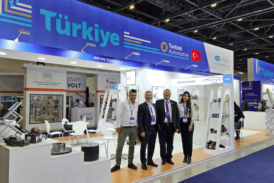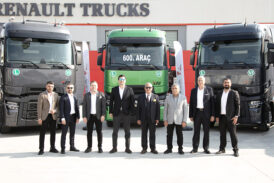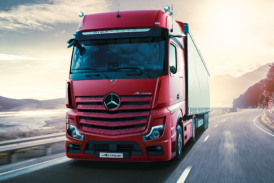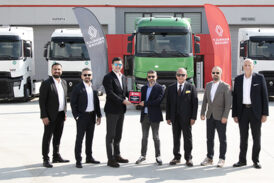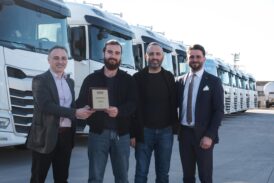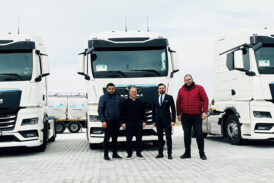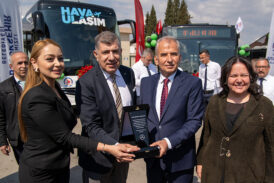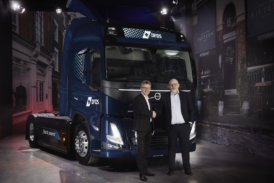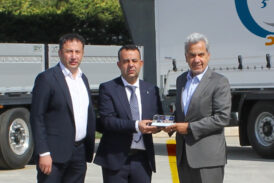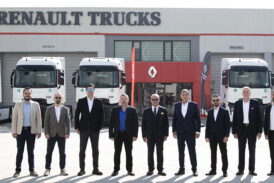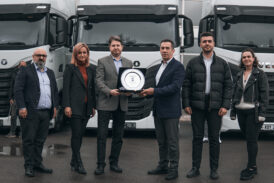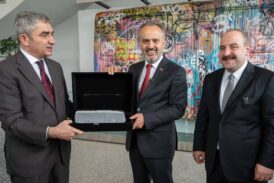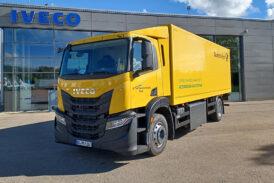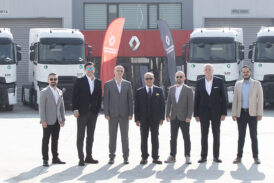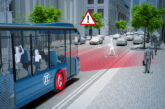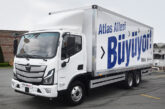Autonomous, connected and electric (ACE) vehicles are the future of commercial transportation. As technology innovations bring the industry closer to ACE fleets, the disruption to the logistics industry will be on par with the transformation that cloud computing and the Internet of Things is bringing across other industries.

Autonomous driving will make trucks, buses and trailers safer and more efficient. But the ACE revolution also brings along risks that the commercial vehicles (CV) industry hasn’t faced before.
With more vehicles connected to the cloud via telematic systems—and more to become connected to each other via vehicle-to-everything (V2X) mesh networks—the complexity of the network creates new nodes and potential entry points for cybersecurity breaches. Consequently, fleet owners and operators must consider the growing impact of cybersecurity, along with the financial and safety implications.

The industry and its stakeholders need to understand how to solve the growing exposure to cyberattacks. This article takes a look at the cybersecurity threats, the risks they create and the solutions the automotive industry is implementing—including the leadership role ZF’s new Commercial Vehicle Control Systems division is taking to address cybersecurity by leveraging its recent acquisition of WABCO, a leading global supplier of commercial vehicle technology.
Increased Exposure from Connected Technology
Global research company MarketsandMarkets projects the global connected trucks market to grow to USD 37.64 billion by 2022, up from USD 18.60 billion in 2017. Frost & Sullivan, a global market research and analysis firm, forecasts that 43% of commercial trucks in Europe and 55% in North America will be connected by 2025. This trend will continue to grow, transforming the day-to-day operations of the supply chain.
Some of the many benefits of ACE vehicles include improved safety, fuel efficiency and fleet management, as well as reduction in operating costs. There are also challenges, however, particularly when it comes to the need for sophisticated cybersecurity.
One of the main security challenges stems from the fact that basic automotive technologies have evolved from on-board, standalone systems to complex, interconnected and intraconnected systems. Not only do they now communicate directly to the internet and the cloud, but they also rely on increasingly complex software.
Looking at how electronic control units (ECUs) function in today’s vehicles makes it clear that they are no longer solely mechanical systems. They’ve become software-based, intelligent and connected systems with a complicated IT infrastructure to support them.
“Today’s passenger vehicles have as many as a hundred ECUs, compared to only five ECUs two decades ago—and instead of each ECU controlling one task, the functions are distributed across multiple ones,” says Florian Rehm, Commercial Vehicle Control Systems – ZF Group, cybersecurity expert. “Additionally, a high-end car contains as many as 100 million lines of code, five times more than in fighter planes. We see these trends reflected in commercial vehicles as well, and all of this IT complexity creates potential new attack vectors for cybercriminals.”
Take the Controller Area Network (CAN) as an example. The CAN communication protocol is a standard describing how information is exchanged between different components and sensors inside a vehicle. Like other automotive technologies (including ECUs), the CAN was not designed to be connected to the internet.
Developed in the early 1980s, this onboard network operates on the premise of “trust.” In a connected environment, this principle leaves the door open for malicious attackers to gain control over the vehicles and manipulate them remotely. By speaking in the name of an ECU, an attacker can easily trigger arbitrary vehicle functions.
A common protocol for the CAN in commercial vehicles is SAE J1939. This standard, which plays a key role in network ECUs, has been around for many years, and continues to grow in popularity due to its usage in telematics while ensuring interoperability of different systems. As an open standard, SAE J1939 has vulnerabilities. Academic researchers have shown how easy it would be to launch attacks on a CAN bus using this protocol, if they could get access to the vehicle network. Once they gained that access, the researchers could control critical systems, including the ability to accelerate a vehicle in motion and disable the brakes.

New Technologies Bring Financial and Safety Risks
The growing adoption of interconnected telematics systems and technologies such as IoT (Internet of Things) are changing the industry landscape.
“Fleets generate US $1 billion in inefficiencies every year, and interconnected technologies enable the transportation industry to optimize operations, cut costs and gain more accurate and granular tracking of vehicles and cargo,” says Christian Urban-Seelmann, who leads the product risk assessment team in ZF’s Commercial Vehicle Control System division. “But at the same time, these technologies are introducing new financial and safety risks.”
Safety: The commercial vehicle industry has a longstanding tradition of focusing on the functional safety of the trucks and their components. Based on years’ worth of captured data related to vehicle dynamics controls, the industry has successfully mitigated safety hazards originating from the road. However, in the connected environment, functional safety also needs to mitigate risks that come from “off the road”—and that’s what cybersecurity needs to take into consideration.
For example, cyber attackers could take advantage of the internet and cloud connectivity to send malicious commands to a vehicle and disable the brakes or manipulate steering. We saw a demonstration of this on the passenger vehicles side, when security researchers were able to slam the brakes and turn the steering wheel on a Jeep Cherokee by sending messages via the CAN. Doing the same in a commercial vehicle could have devastating results not just for the driver but also for other road occupants and the environment.
Addressing the off-the-road risks is a bigger challenge than on-the-road risk. Unlike road hazards, cyber attacks are more difficult to predict and modelize.
Financial: Industry stakeholders ranging from OEMs to fleet operators could be impacted financially due to cybersecurity shortcomings.
For OEMs, consider what happened to Fiat Chrysler. After researchers exposed the Jeep Cherokee security flaws, the company had to recall 1.4 million vehicles, including other models that shared the same vulnerability. The U.S. National Highway Traffic Safety Administration also opened an investigation, and the company’s stock value dropped by 20% within two weeks of the hack disclosure.
For fleet operators, losses linked to cyber crimes can be very significant in multiple ways. From a financial standpoint, the direct repair cost to a damaged vehicle can be quite high. But, the indirect costs linked to stolen vehicles cargo value can also be substantial. The same is true for the value of lost contracts resulting from the damage to the reputation of attacked fleets. No type of cargo is currently spared by thefts because every transported good has a value.
Impact of Connected Vehicles on Supply Chain Security
Supply chain security is a major concern across all industries, but especially for the manufacturing and logistics sectors. Cargo theft has been growing in recent years, and the increasing amount of connected vehicles on our roads gives different stakeholders the opportunity to look for solutions.
According to the Transportation Asset Protection Association, the estimated average daily loss from supply chain was 378,058 EU in the EMEA region (Europe, Middle East and Africa) in 2019, and the combined loss of major crimes (100,000 EU or more) over 12 months was more than 96 million EU. In the US, the cost of cargo crime is estimated at 10-25 billion USD per year. Only a fraction of the thefts are actually reported, so the losses are much higher in reality.
Theft from road vehicles accounts for the majority of cargo thefts. In the past, the biggest problem was related to physical security. But supply chain security is evolving beyond the traditional environment to the digital realm.
Taking advantage of technology, cargo thieves could hack into an online tracking portal to access manifests, pick up information and other sensitive data; re-route cargo to a different destination by spoofing information; or pick up cargo using forged documents.
Current Automotive Cybersecurity Technologies Leave Gaps
Up to now, automotive technologies have not taken a security-by-design approach. The industry is now recognizing the importance of cybersecurity; however, adoption of security measures has been slow.
A study commissioned by SAE International and Synopsis found that 84% of the nearly 16,000 IT professionals surveyed in the automotive industry were concerned that cybersecurity practices were not keeping up with the evolving technologies. Yet, 30% of the respondents said their organization didn’t have a cybersecurity program or team, and 63% tested less than half of their technologies for vulnerabilities.
“Individual industries often come up with cybersecurity solutions that fit their unique needs,” Urban-Seelmann says. “In the automotive sector, that’s a challenge because off-the-shelf solutions cannot be applied to CVs due to the data processing limitations of embarked processors and their specific operational environment.”
Since the potential solutions are very product specific, and mechanisms need to be embedded both in software and hardware, each solution is limited in fixing the flaws.
As a result of the emerging cybersecurity threats and the rising concerns about the associated risks, the industry has organized itself to work on the problem. Leaders from across the passenger and commercial vehicle sectors have been collaborating on defining solutions, and we’re starting to see the results.
Regulations, Standardization Aim to Improve Security
Regulatory bodies and industry groups are leading efforts to standardize cybersecurity requirements. In the long term, it is expected that providing a framework for the industry to follow will improve the cybersecurity environment.
Two current initiatives to standardize requirements are of note, spearheaded separately by UNECE and by ISO/SAE.
UNECE: The UN Task Force on Cybersecurity and Over-the-Air (OTA), established in 2016, has been working on an automotive cybersecurity regulation. The proposal includes requirements for vehicles (such as architecture design, risk assessments and security mitigations) and for the cybersecurity management systems (including governance and processes, cybersecurity culture and policies, and incident management and response).
The draft regulation included a test phrase in 2019, with more than 15 OEMs participating. Following the upcoming formal adoption of UN WP.29 of the UNECE regulation, new whole vehicle types will need to comply in 2022, and the rest in 2024.
Adopting these standards creates urgency for the industry. OEMs and suppliers do not have much time left to prepare for approval according to UNECE specifications without any additional effort in the future.
ISO/SAE: A joint project by ISO and SAE began in October 2016 to standardize automotive cybersecurity engineering. The main principles of ISO/SAE 21434 focus on a risk-oriented approach, as well as cybersecurity processes for all phases of vehicle lifecycle: design and engineering, production, operation, maintenance and service, and decommissioning.
The standard is in draft form, and a final draft is expected later in 2020 or in 2021.
Prior to being acquired by ZF in May 2020, WABCO has been part of the ISO/SAE and UNECE cybersecurity discussions, and started to implement the new ISO/SAE standards in 2017 when the first draft became available. Since then, we’ve implemented the majority of the requirements.
ZF Takes Leadership Role
ZF’s division CVCS strategy is best summarized by Christian Brenneke – Senior Vice President – Product Engineering, Commercial Vehicle Control Systems division: “Today’s digital technology is the foundation of our knowledge-based society and enables mind boggling opportunities, but as systems become more connected and integrated, we see the number of vulnerabilities growing. This is why the implementation of dedicated cybersecurity standards has to be a top priority in our commercial vehicle industry as well as ensuring a security- by-design approach for every step of our development projects’ life cycles starting from their specifications all the way to their validation.”
Designing safety products is in our DNA. We were first to introduce WABCO ABS for commercial vehicles, as one example. We’ve continued that longstanding tradition of being an industry leader by taking a security-by-design approach since 2018, going beyond safety-by-design. Our position is that safety cannot be reached without security—the two must work together.
“Our management has recognized early that cybersecurity will be important because safety cannot be guaranteed without cybersecurity. When designing a new product, we start by analyzing the risks and potential threats in the context of a connected and autonomous driving environment,” he explains. “We have tested the early versions of our products to understand their resistance to cyberattacks, and we also monitor hacker forums to stay on top of how our products are misused. We have also started to evaluate all of our suppliers regarding cybersecurity, and have integrated that into the development process.”, notes Rehm.
The introduction of WABCO’s connected OptiLock ELB-Lock® door locking solution, combined with the Transics TX-TRAILERGUARD trailer telematics system, was a good illustration of our approach and a big step toward providing cargo security, according to Charlotte Belhadjoudja, Global Product Manager for Security Solutions.
“This combination grants full, real-time visibility of the fleet’s status from behind the screen along with remote cargo monitoring,” Belhadjoudja says. “Although this innovative solution positioned us as a market leader, we recognized it was only the first building block. Always driven to go further, we are now working on the next generation of locking systems which further reinforces security levels to counter the evolving cyberattack techniques.”

Other examples include:
- ADOPT, or Autonomous Driving Open Platform Technology. Announced at IAA 2018, ADOPT is a cybersecurity-ready project in its early stages of innovation. It translates driving instructions from virtual driver applications (autonomous driving artificial intelligence) to real vehicle motion commands and enables the control of all the relevant vehicle actuation systems. The resulting vehicle motion control is executed under safety and efficiency principles, benefiting from ZF’s industry leading experience in vehicle dynamics and powertrain control.
- We have launched a new responsible-disclosure program for security researchers and others to submit security vulnerabilities directly to us. This program enables individuals to reach out to WABCO via an encrypted communication channel and contact one of our experts directly.
What’s Next
Over-the-air software updates, IoT (Internet of Things) and automated vehicles are among the other trends that will drive advances in the next generations of CVs. The industry will continue to transform and innovate, but progress is not possible without an emphasis in cybersecurity.
As the industry looks to the future, it’s critical to understand the risks of these new technologies—and put mechanisms in place to address these risks. For our part, ZF will continue to advocate for and be an early adopter of cybersecurity, and accompany its fleets and OEM customers in their journey to implement the associated proven secure solutions. This starts by being certified in the new UNECE cybersecurity standards when the final document is published. And as new technology emerges, ZF will continue to be an active part of the conversation on how to ensure commercial vehicles are safe and secure.




